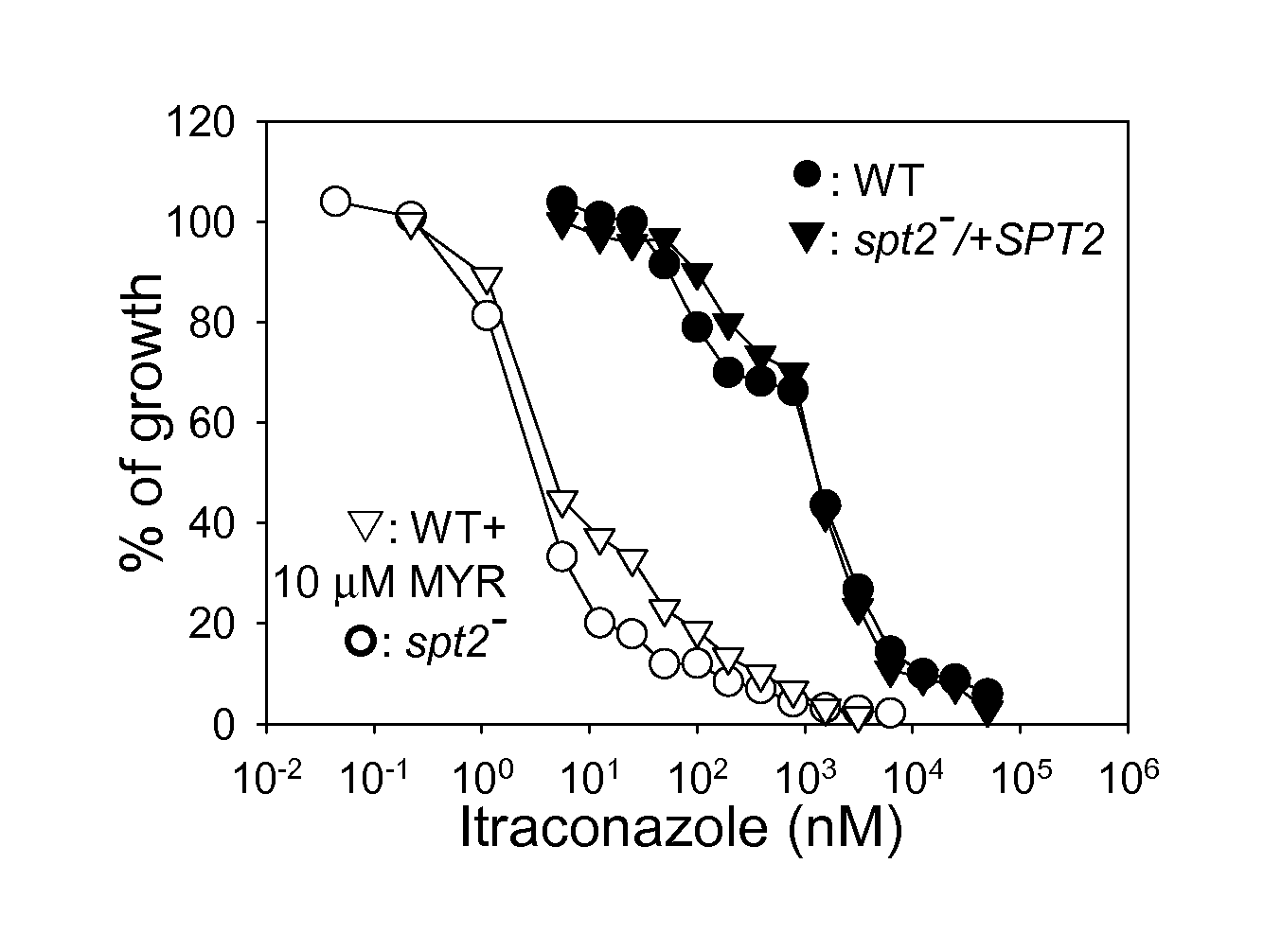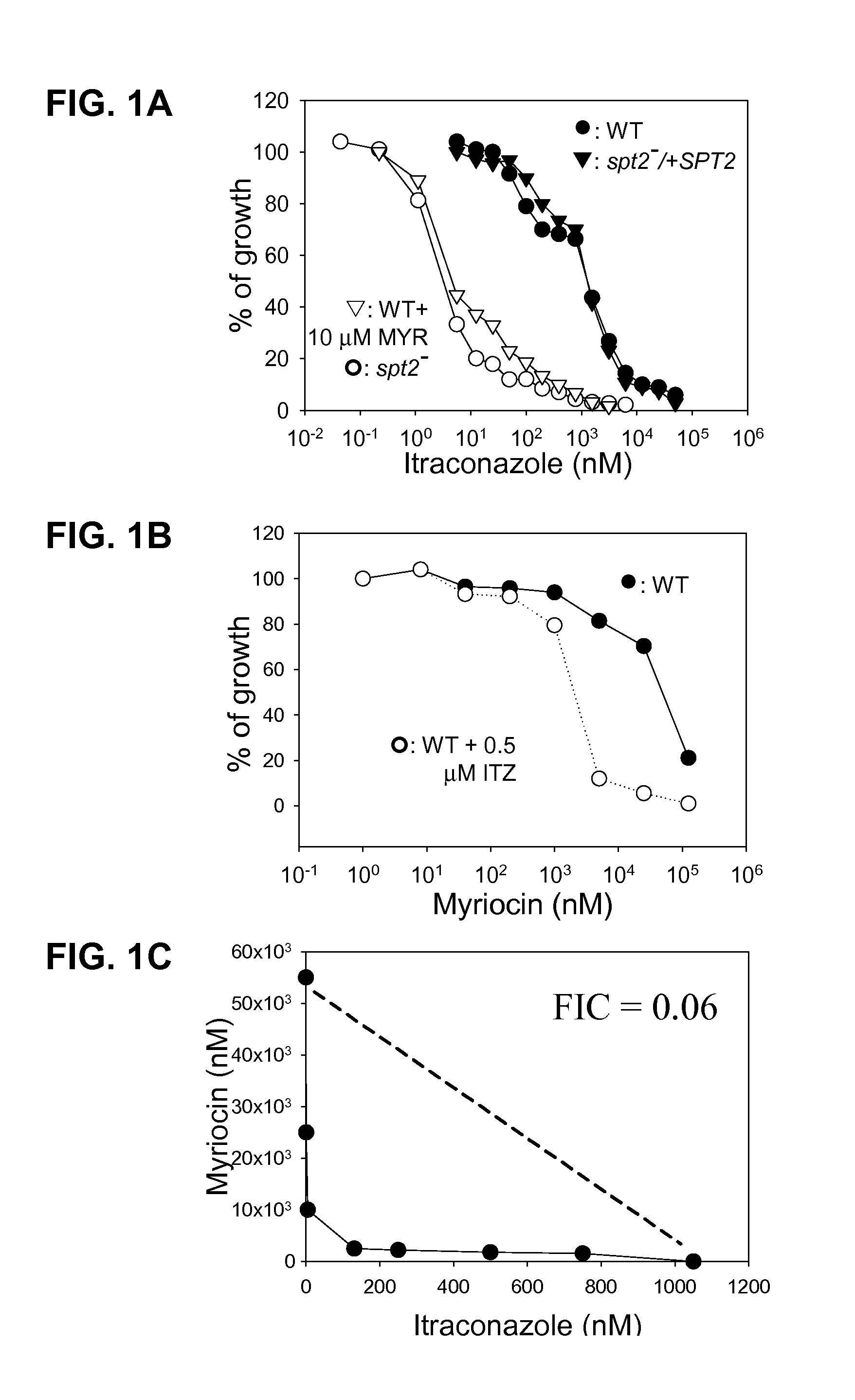Compositions and methods for inhibiting protozoan growth
a protozoan growth and compound technology, applied in the field of compounding and methods for inhibiting protozoan growth, can solve the problems of limited effectiveness, high toxicity, widespread resistance, etc., and achieve the effects of not having harmful side effects, not difficult or expensive to administer, and sufficient
- Summary
- Abstract
- Description
- Claims
- Application Information
AI Technical Summary
Benefits of technology
Problems solved by technology
Method used
Image
Examples
example 1
Loss of SL Synthesis Leads to Hypersensitivity to Itraconazole and Ketoconazole in L. major Promastigotes
[0122]Anti-fungal drugs itraconazole (ITZ) and ketoconazole (KEZ) are potent inhibitors of the cytochrome P450-dependent lanosterol 14α-demethylase [Georgopapadakou, 1998; Georgopapadakou, et al 1996], a key enzyme in the synthesis of ergosterol. Both drugs have shown to possess anti-leishmanial activity against promastigotes and amastigotes [Hart, et al., 1989; Zakai, et al., 2000]. For L. major LV39 clone 5 wild type (WT) parasites, EC50s (concentrations of drugs required to inhibit growth by 50%) for ITZ and KEZ were around 1.1 μM and 3.1 μM, respectively (FIGS. 1A and 1D), similar to published values in other Leishmania species [Berman, et al., 1984; Beach, et al., 1988]. SL-null spt2− parasites were extremely sensitive to ITZ and KEZ, as their EC50s (3.9 nM for ITZ and 10 nM for KEZ) were about 300 times lower than LV39 WT parasites (FIGS. 1A and 1D). This susceptibility is ...
example 2
Combinations of MYR and ITZ Inhibit the Growth of L. major Promastigotes Synergistically
[0123]The fact that MYR (10 μM) treatment drastically increased the susceptibility of LV39 WT parasites to ITZ (EC50 was reduced from 1.1 μM to 4.6 nM, FIG. 1A) prompted examination of whether ITZ could also work synergistically with MYR. Indeed, without ITZ, the EC50 for MYR in LV39 WT parasites was about 55 μM (very close to the solubility limit), whereas in the presence of 0.5 μM ITZ, it dropped to about 1.8 μM (FIG. 1B). Furthermore, combinations of these two drugs were tested and EC50s were determined as following: no ITZ / 55 μM MYR, 0.92 nM ITZ / 25 μM MYR, 4.6 nM ITZ / 10 μM MYR, 131 nM ITZ / 2.5 μM MYR, 250 nM ITZ / 2.2 μM MYR, 500 nM ITZ / 1.8 μM MYR, 750 nM ITZ / 1.5 μM MYR, and 1.1 μM ITZ / no MYR. These results were plotted on a classical isobologram (FIG. 1C) and the fractional inhibitory concentration (FIC) was determined to be 0.06 (FICL. major promastigotes [Hallander, et al., 1982]. This synerg...
example 3
ITZ Inhibits Targets Beyond Lanosterol 14a-demethylase in Leishmania promastigotes
[0126]To test whether ITZ inhibits the same target in L. major as in fungi, a putative lanosterol 14α-demethylase (LmC14DM) gene was identified in L. major, which was ˜48% identical to the C14DM in A. fumigates at the amino acid level (FIG. 5). This gene was then cloned and integrated into the small ribosomal unit site of both WT (WT SSU::C14DM) and spt2− (spt2− SSU:C14DM) parasites to achieve a high level of expression [Robinson, et al., 2003] as described in the Materials and Methods below. Both control and transfected parasites were tested for sensitivity to ITZ, and results were shown in FIG. 1G. Overexpression of LmC14DM did buffer the effect of ITZ on sterol composition at low nanomolar range (Table 2). However, such overexpression only conferred ˜ten-fold increase in EC50 in spt2−, and had very little effect on WT parasites (FIG. 1G), suggesting LmC14DM is not the only target of ITZ in L. major...
PUM
| Property | Measurement | Unit |
|---|---|---|
| Molar density | aaaaa | aaaaa |
| Molar density | aaaaa | aaaaa |
| Fraction | aaaaa | aaaaa |
Abstract
Description
Claims
Application Information
 Login to View More
Login to View More - R&D
- Intellectual Property
- Life Sciences
- Materials
- Tech Scout
- Unparalleled Data Quality
- Higher Quality Content
- 60% Fewer Hallucinations
Browse by: Latest US Patents, China's latest patents, Technical Efficacy Thesaurus, Application Domain, Technology Topic, Popular Technical Reports.
© 2025 PatSnap. All rights reserved.Legal|Privacy policy|Modern Slavery Act Transparency Statement|Sitemap|About US| Contact US: help@patsnap.com



